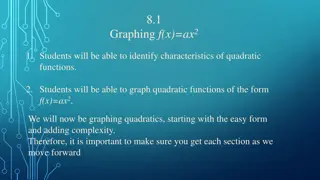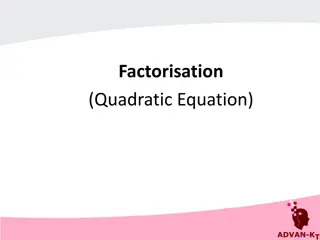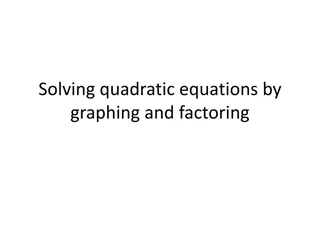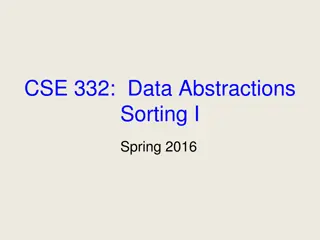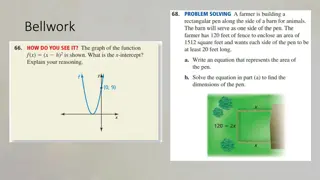Overview of Sorting Algorithms and Quadratic Sorting - CS 330 Lecture Notes
Sorting algorithms play a crucial role in computer science and computing tasks, consuming a significant portion of computing power. Various algorithms such as Bubble Sort, Selection Sort, and Insertion Sort are discussed for sorting a list of values efficiently. Quadratic sorting algorithms like Selection Sort, Insertion Sort, and Bubble Sort have O(n^2) worst and average case performance. Bubble Sort, in particular, compares adjacent numbers and swaps them if necessary to sort the list efficiently. Different sorting techniques and their efficiencies are explored in detail in the CS 330 lecture notes on the design and analysis of algorithms.
Download Presentation

Please find below an Image/Link to download the presentation.
The content on the website is provided AS IS for your information and personal use only. It may not be sold, licensed, or shared on other websites without obtaining consent from the author. Download presentation by click this link. If you encounter any issues during the download, it is possible that the publisher has removed the file from their server.
E N D
Presentation Transcript
Sorting Algorithms Sorting Algorithms CS 330 Intro to the Design and Analysis of Algorithms Lecture note Sajedul Talukder
Introduction Common problem: sort a list of values, starting from lowest to highest. List of exam scores Words of dictionary in alphabetical order Students names listed alphabetically Student records sorted by ID# Generally, we are given a list of records that have keys. These keys are used to define an ordering of the items in the list.
Sorting To arrange a set of items in sequence. It is estimated that 25~50% of all computing power is used for sorting activities. Possible reasons: Many applications require sorting; Many applications perform sorting when they don't have to; Many applications use inefficient sorting algorithms.
Sorting: The Big Picture Horrible algorithms: (n2) Simple algorithms: O(n2) Fancier algorithms: O(n log n) Bogo Sort Stooge Sort Comparison lower bound: (n log n) Insertion sort Selection sort Bubble Sort Shell sort Specialized algorithms: O(n) Heap sort Merge sort Quick sort (avg) Bucket sort Radix sort
Quadratic Sorting Algorithms We are given n records to sort. There are a number of simple sorting algorithms whose worst and average case performance is quadratic O(n2): Selection sort Insertion sort Bubble sort
Bubble Sort Given n numbers to sort: Repeat the following n-1 times: For each pair of adjacent numbers: If the number on the left is greater than the number on the right, swap them How efficient is bubble sort? In general, given n numbers to sort, it performs n2 comparisons The same as selection sort Is there a simple way to improve on the basic bubble sort? Yes! Stop after going through without making any swaps This will only help some of the time
Bubble Sort Bubble sort examines the array from start to finish, comparing elements as it goes. Any time it finds a larger element before a smaller element, it swaps the two. In this way, the larger elements are passed towards the end. The largest element of the array therefore "bubbles" to the end of the array. Then it repeats the process for the unsorted portion of the array until the whole array is sorted.
Bubble Sort Search for adjacent pairs that are out of order. Switch the out-of-order keys. Repeat this n-1 times. After the first iteration, the last key is guaranteed to be the largest. If no switches are done in an iteration, we can stop.
N-1 Iteration 1 2 3 4 5 6 77 5 101 42 35 12 1 2 3 4 5 6 5 77 101 35 12 42 1 2 3 4 5 6 N - 1 42 77 101 12 35 5 1 2 3 4 5 6 42 77 101 12 5 35 1 2 3 4 5 6 42 77 101 5 12 35
Reducing the Number of Comparisons 1 2 3 4 5 6 12 101 5 77 42 35 1 2 3 4 5 6 77 5 101 42 35 12 1 2 3 4 5 6 5 77 101 35 12 42 1 2 3 4 5 6 42 77 101 12 35 5 1 2 3 4 5 6 42 77 101 12 5 35
Reducing the Number of Comparisons On the Nth bubble up , we only need to do MAX-N comparisons. For example: This is the 4th bubble up MAX is 6 Thus we have 2 comparisons to do 1 2 3 4 5 6 42 77 101 12 35 5
Bubble Sort void bubbleSort(int arr[]) { int n = arr.length; for (int i = 0; i < n-1; i++) for (int j = 0; j < n-i-1; j++) if (arr[j] > arr[j+1]) { // swap arr[j+1] and arr[j] int temp = arr[j]; arr[j] = arr[j+1]; arr[j+1] = temp; } } To do N-1 iterations To bubble a value Outer loop Inner loop
Bubble Sort Time Complexity Best-Case Time Complexity The scenario under which the algorithm will do the least amount of work (finish the fastest) Worst-Case Time Complexity The scenario under which the algorithm will do the largest amount of work (finish the slowest)
Bubble Sort Time Complexity Called Linear Time O(N) Order-of-N Best-Case Time Complexity Array is already sorted Need 1 iteration with (N-1) comparisons Called Quadratic Time O(N2) Order-of-N-square Worst-Case Time Complexity Need N-1 iterations (N-1) + (N-2) + (N-3) + . + (1) = (N-1)* N / 2
Selection sort selection sort: orders a list of values by repetitively putting a particular value into its final position more specifically: find the smallest value in the list switch it with the value in the first position find the next smallest value in the list switch it with the value in the second position repeat until all values are in their proper places
Selection Sort 22 12 22 6 8 14 17 12 22 12 8 6 12 14 14 17 17 22 22 22 17 Given n numbers to sort: Repeat the following n-1 times: Mark the first unsorted number Find the smallest unsorted number Swap the marked and smallest numbers
Selection Sort Given n numbers to sort: Repeat the following n-1 times: Mark the first unsorted number Find the smallest unsorted number Swap the marked and smallest numbers How efficient is selection sort? In general, given n numbers to sort, it performs n2 comparisons Why might selection sort be a good choice? Simple to write code Intuitive
Selection Sort while some elements unsorted: Find the smallest element in the unsorted section; this requires all of the unsorted items to be compared to find the smallest Swap the smallest element with the first (left-most) element in the unsorted section smallest so far: 45 36 22 13 16 21 45 79 47 22 60 74 36 66 94 22 45 57 38 29 81 the fourth iteration of this loop is shown here
Selection Sort Algorithm public void selectionSort(Comparable[] arr) { for (int i = 0; i < arr.length-1; ++i) { int smallest = i; // Find the index of the smallest element for (int j = i + 1; j < arr.length; ++j) { if (arr[j].compareTo(arr[smallest])<0) { smallest = j; } } // Swap the smallest with the current item Comparable temp = arr[i]; arr[i] = arr[smallest]; arr[smallest] = temp; } }
Selection Sort: Number of Comparisons Elements in unsorted n n-1 Comparisons to find min n-1 n-2 3 2 1 2 1 0 n(n-1)/2
Selection Sort: Analysis Number of comparisons: (n-1) + (n-2) + ... + 3 + 2 + 1 = n * (n-1)/2 = (n - n )/2 O(n ) Number of exchanges (worst case): n 1 O(n) Overall (worst case) O(n) + O(n ) = O(n ) ( quadratic sort )
Selection Sort Analysis public void selectionSort(Comparable[] arr) { for (int i = 0; i < arr.length-1; ++i) { // outer for loop is evaluated n-1 times int smallest = i; //n-1 times again for (int j = i + 1; j < arr.length; ++j) { // evaluated n(n-1)/2 times if (arr[j].compareTo(arr[smallest])<0) { // n(n-1)/2 comparisons smallest = j; //how many times? (*) } } Comparable temp = arr[i]; //n-1 times arr[i] = arr[smallest]; //n-1 times arr[smallest] = temp; //n-1 times } }
Insertion Sort Simple sorting algorithm that works the way we naturally sort playing cards in our hands. While some elements unsorted: Using linear search, find the location in the sorted portion where the 1st element of the unsorted portion should be inserted Move all the elements after the insertion location up one position to make space for the new element
Insertion Sort insertion sort: orders a list of values by repetitively inserting a particular value into a sorted subset of the list more specifically: consider the first item to be a sorted sublist of length 1 insert the second item into the sorted sublist, shifting the first item if needed insert the third item into the sorted sublist, shifting the other items as needed repeat until all values have been inserted into their proper positions
Insertion Sort Simple sorting algorithm. n-1 passes over the array At the end of pass i, the elements that occupied A[0] A[i] originally are still in those spots and in sorted order. 2 15 8 1 17 10 12 5 0 1 2 3 4 5 6 7 after pass 2 2 8 15 1 17 10 12 5 0 1 2 3 4 5 6 7 after pass 3 1 2 8 15 17 10 12 5 0 1 2 3 4 5 6 7
Insertion Sort Code void sort(int arr[]) { int n = arr.length; for (int i=1; i<n; ++i) { int key = arr[i]; int j = i-1; /* Move elements of arr[0..i-1], that are greater than key, to one position ahead of their current position */ while (j>=0 && arr[j] > key) { arr[j+1] = arr[j]; j = j-1; } arr[j+1] = key; } }
Insertion Sort Complexity How many compares are done? 1+2+ +(n-1), O(n2) worst case (n-1)* 1 , O(n) best case How many element shifts are done? 1+2+...+(n-1), O(n2) worst case 0 , O(1) best case How much space? In-place algorithm Best Case: O(n), if given in sorted order. Worst Case: O(n^2), if given in reverse order. Average Case: O(n^2), still a quadratic running time.
Insertion Sort: Analysis Number of comparisons (worst case): (n-1) + (n-2) + ... + 3 + 2 + 1 O(n ) Number of comparisons (best case): n 1 O(n) Number of exchanges (worst case): (n-1) + (n-2) + ... + 3 + 2 + 1 O(n ) Number of exchanges (best case): 0 O(1) Overall worst case: O(n ) + O(n ) = O(n )








